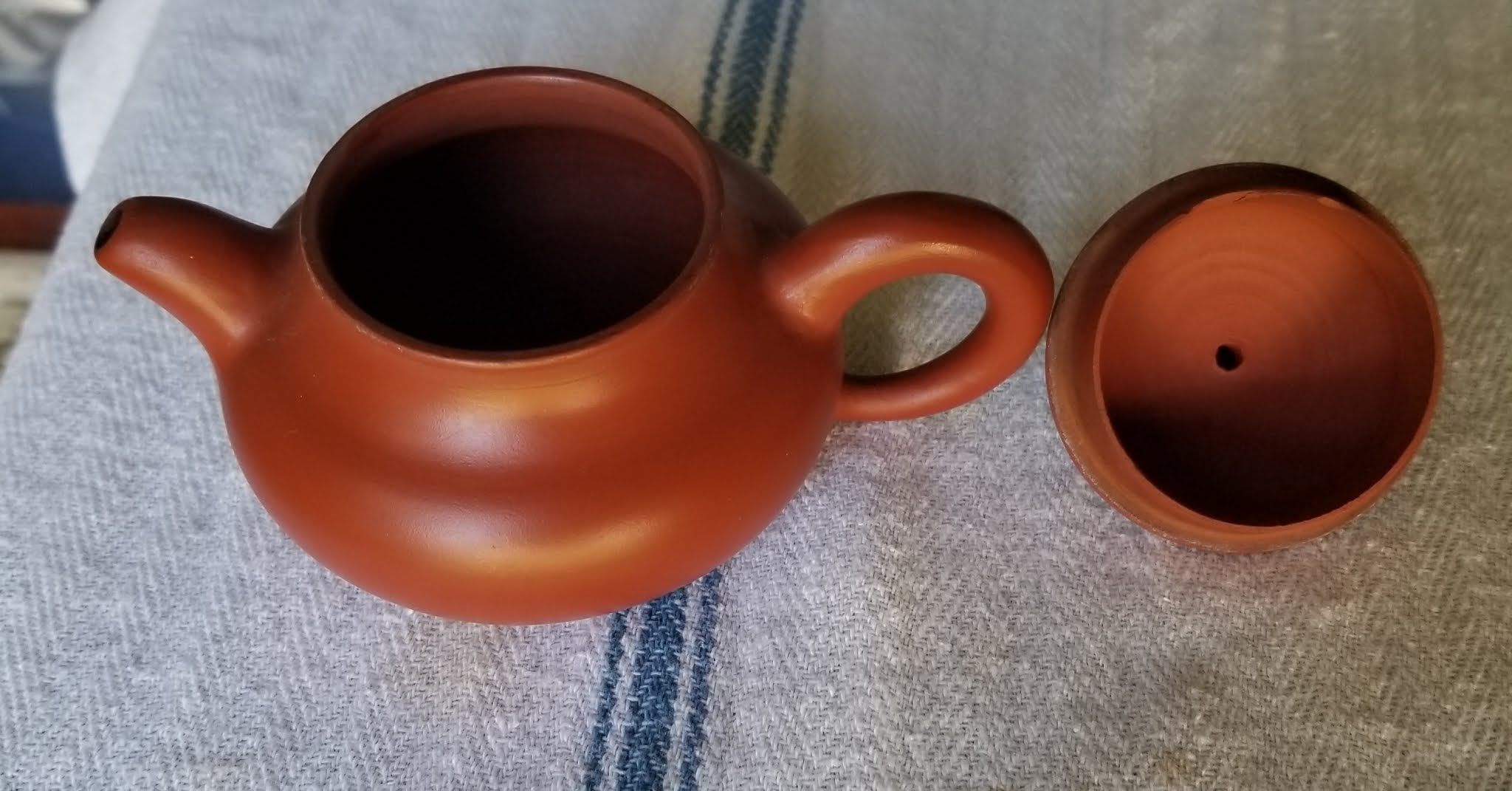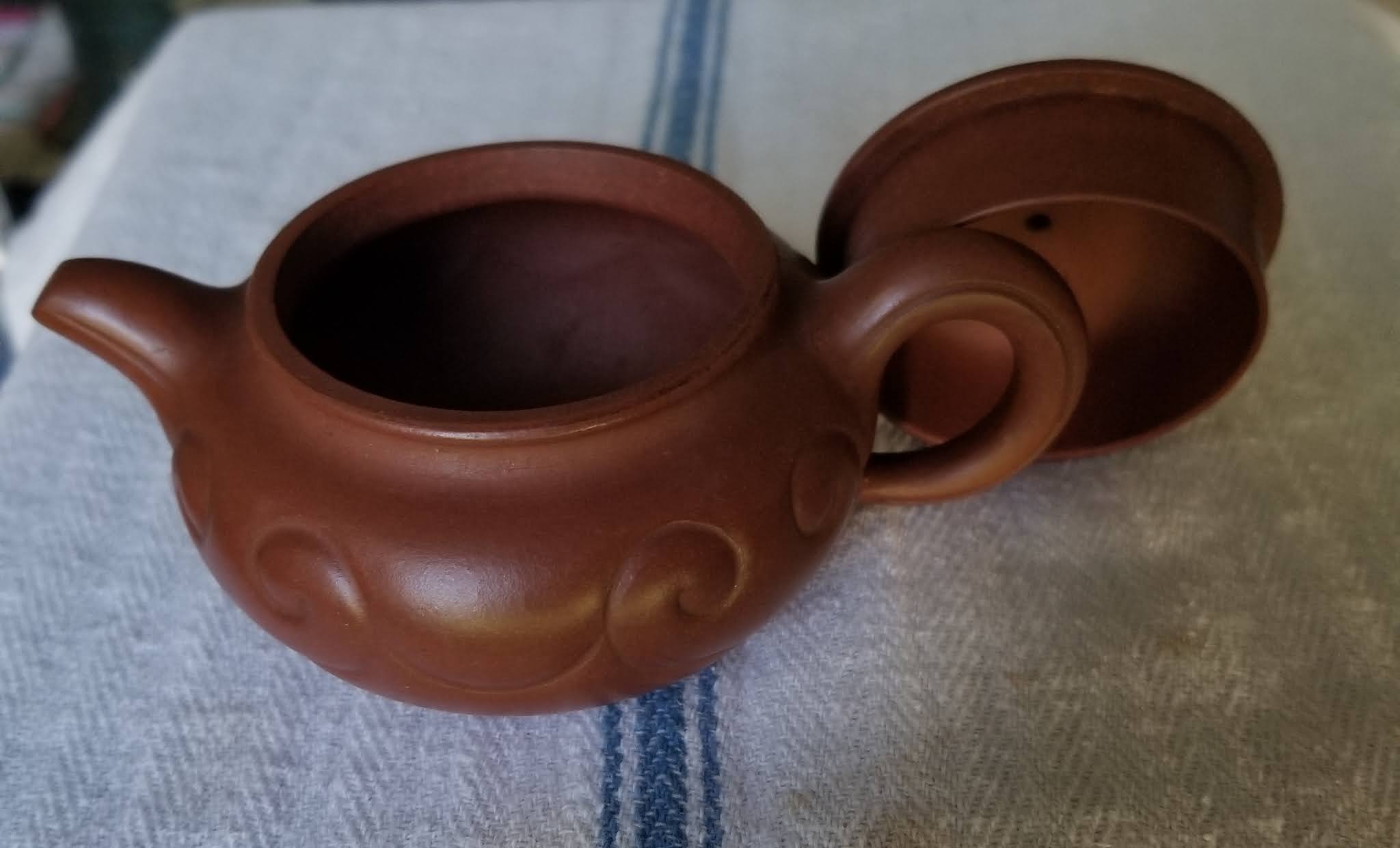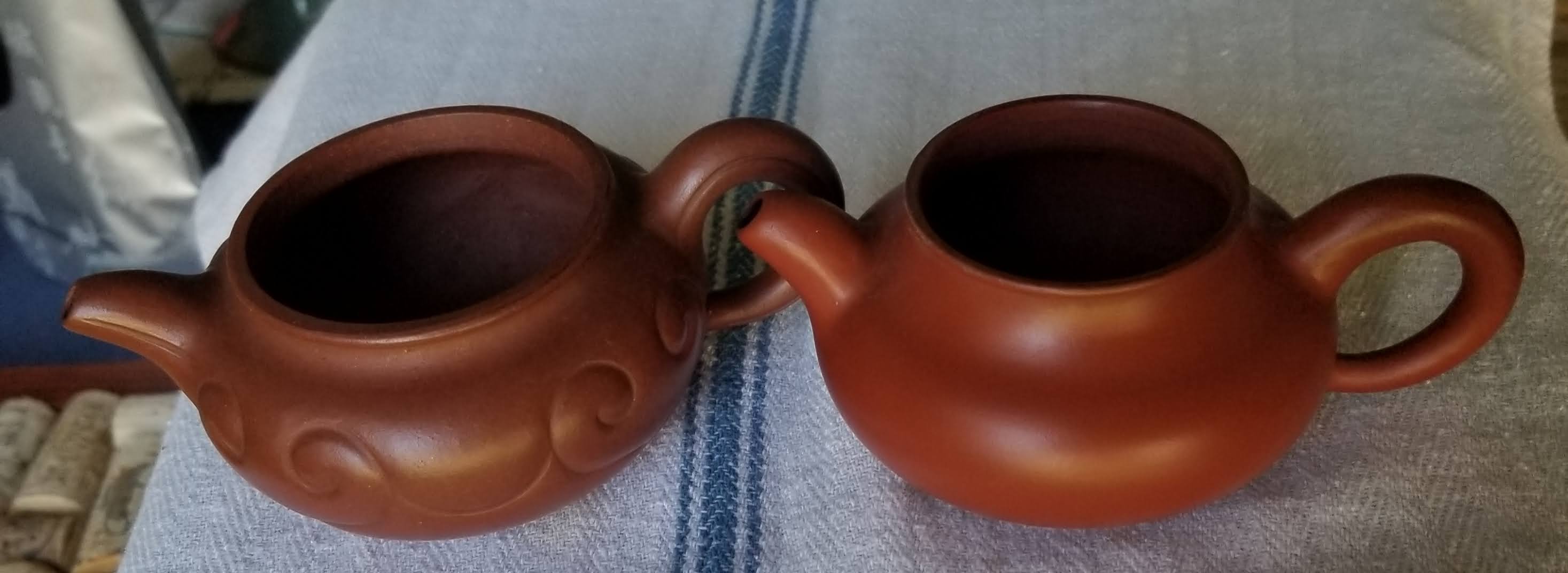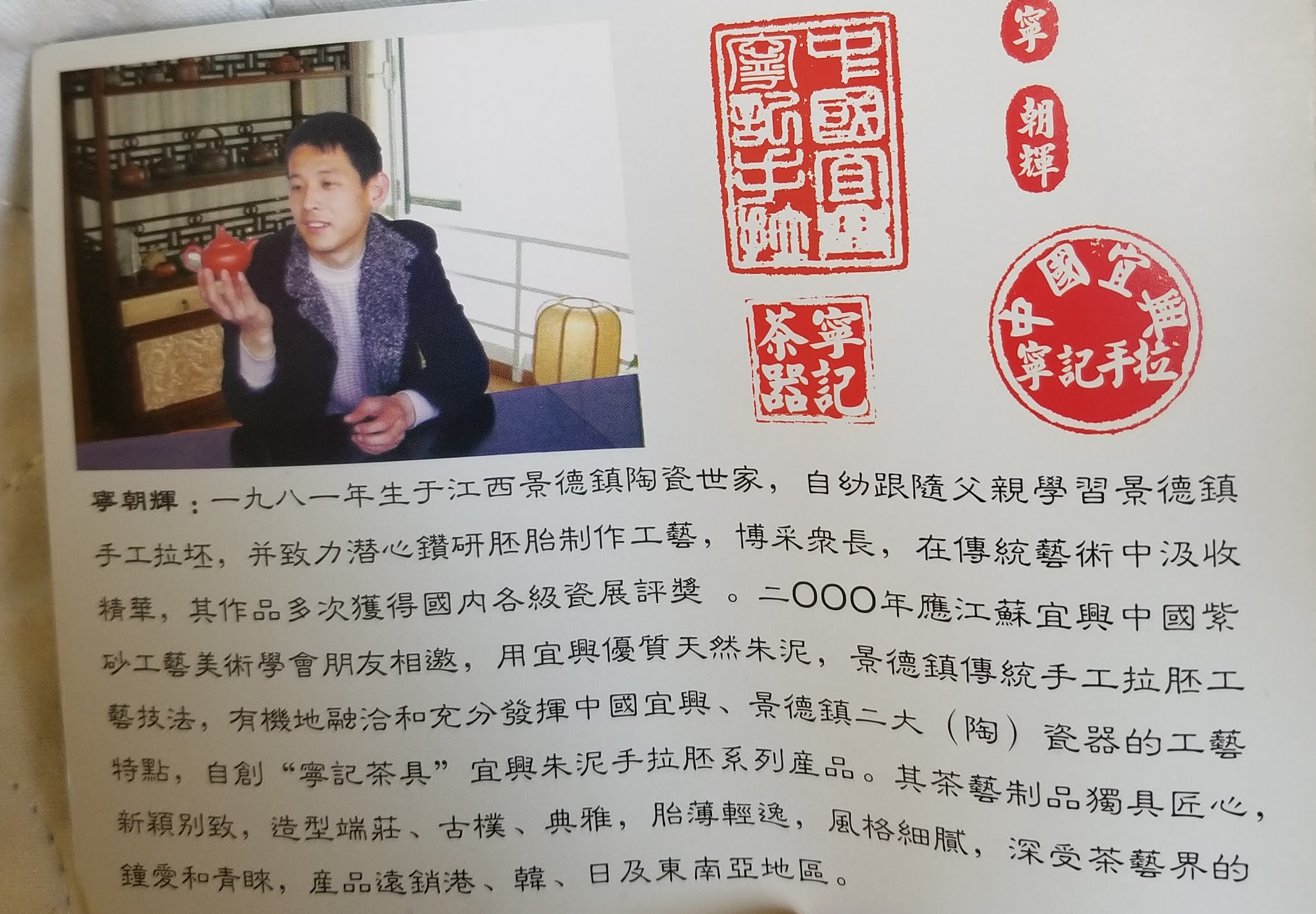Can you take a photo of both puts under brighter lighting?? Preferably natural sunlight.LeoFox wrote: ↑Sat Oct 03, 2020 8:56 pmI recently received two pots from my aunt in China. Pot 1 was purchased early 2000s during some chinese art show. Pot 2 was purchased much earlier, She doesn't remember when or the circumstances (she is in her 70s).
I think pot 1 was clearly wheel thrown. Maybe a cz.
I was wondering if i could get some expert thoughts on these pots. Thank you for your help!
Yixing advice
Thank you for the warnings. Prompted me to do a few more tests.Bok wrote: ↑Sun Oct 04, 2020 12:18 amLeoFox actually, I want to revise my assessment: if pot A is Chaozhou it does not look like pure Chaozhou clay, more like some modern clay that could be anything.
Same for pot B, what I meant by modern Hongni is that “who knows what’s in there, non descript red clay”
I soaked the pots overnight in hot filtered water and then rinsed them several times in boiling water. After that i incubated boiling water in each for 10 minutes and tasted the water side by side against same water in a glass cup (control). I also measured temperature.
Despite much thicker walls, pot 2 had only 3 C higher temp water than pot 1.
I found both pots generated water that was less smooth than the control. Pot 1 water tasted a little muddier, with a mild flavor of overbrewed geen tea. Pot 2 had some "rockiness' and slight muddiness.
When stuck with its own lid, pot 2 sounds dull. It also feels relatively heavy. The outside feels smooth and almost glossy throughout, while inside is a bit more gravelly. I worry there might be some kind of plastic coating on the outside. Aunt claims she has never used it but it looks a little stained, and i see bits of dried leaf fragments inside. In terms of the functionality, it is very easy to use. Lid is very tight fitting, and pour is fast. Much easier than my porcelain pot of relatively same size.
Pot 1 pours even more quickly and the lid is tight. When stuck with own lid, the sound is a bit higher than pot 1 but nowhere as high as porcelain. I am slightly bothered by the "muddiness" and the other taste of overbrewed tea (a little reminiscent of some ripe pu-er). She said she used to use this for ball rolled oolong.
Just took these now next to my window. Sunlight is not too strong todayOCTO wrote: ↑Sun Oct 04, 2020 9:28 amCan you take a photo of both puts under brighter lighting?? Preferably natural sunlight.LeoFox wrote: ↑Sat Oct 03, 2020 8:56 pmI recently received two pots from my aunt in China. Pot 1 was purchased early 2000s during some chinese art show. Pot 2 was purchased much earlier, She doesn't remember when or the circumstances (she is in her 70s).
I think pot 1 was clearly wheel thrown. Maybe a cz.
I was wondering if i could get some expert thoughts on these pots. Thank you for your help!
Pot 1

Pot2

Pot1 and 2 side by side

Also, didnt see this at first, but there is some kind of promotional pamphlet in the box with pot 1:

-
pidgeon_smoker
- New user
- Posts: 2
- Joined: Thu Oct 08, 2020 4:37 am
Hey guys. New guy here. I'm in the scavenge to find a pot for my growing collection of semi-aged puerh cakes. I'm already overwhelmed by the options.
From the small knowledge, I have that you need to pay attention to pour time and porosity of the clay, the thickness of the walls. Also the degree of firing temperature.
For now, I'm settled with this offer:
http://zishaartgallery.com/product/8%e6 ... b6-za0147/
It's the type of clay I still have doubts/questions. The opinions from different sources messing me. Is Zhuni or Hungni are the more preferred option for you guys ? If I'm correct the Zini clay would be too muting for semi-aged ?
From the small knowledge, I have that you need to pay attention to pour time and porosity of the clay, the thickness of the walls. Also the degree of firing temperature.
For now, I'm settled with this offer:
http://zishaartgallery.com/product/8%e6 ... b6-za0147/
It's the type of clay I still have doubts/questions. The opinions from different sources messing me. Is Zhuni or Hungni are the more preferred option for you guys ? If I'm correct the Zini clay would be too muting for semi-aged ?
-
polezaivsani
- Posts: 191
- Joined: Sun Oct 06, 2019 4:43 pm
- Location: Kaliningrad, RU
@pidgeon_smoker, i've got my feet wet with Yixing recently and the best advice i have is to not rush picking a pot, but rather begin your journey with a thorough study. I know it might sound less fun than 'go get pot X out Y clay from Z era', but i have a hunch that'll be the wisest option. And it'll spare you a chunk of tuition fees, wich you'll need to pay either way - be it hard knocks, or diligent studies. The Yixing topic would be great introduction. Reading up on it, combined with staring at examples of tea pots would save you and your bank account a good deal of mishaps. Have fun!
@pidgeon_smoker Not cheap, but otherwise an excellent choice IMO. I've never thought of any of my yixing pots as too muting.
-
pidgeon_smoker
- New user
- Posts: 2
- Joined: Thu Oct 08, 2020 4:37 am
https://moodyguy.biz/80s-ning-gao-ni-6-cup-33.html
If I understood correctly from reading the archive of this forum, the Ning Gao Ni is very close/similar to Zhuni? Could this pot be a great choice for semi-aged shengs?
If I understood correctly from reading the archive of this forum, the Ning Gao Ni is very close/similar to Zhuni? Could this pot be a great choice for semi-aged shengs?
I'm on my mobile now, so a bit of a hassle to search myself.. but is "ning gao ni" a typo (should it be nian gao tu/ni)? I have a nian gao tu, green label F1. It's the least muting yixing pot in my collection, but then again I dont own anything zhuni. Personally, I prefer zini/hongni from the same period for semi-aged sheng. My NGT is usually used for oolongs and occasionally black tea.
I ended up using pot 1 for yancha and pot 2 for shu for a few sessions.LeoFox wrote: ↑Sun Oct 04, 2020 9:41 amThank you for the warnings. Prompted me to do a few more tests.Bok wrote: ↑Sun Oct 04, 2020 12:18 amLeoFox actually, I want to revise my assessment: if pot A is Chaozhou it does not look like pure Chaozhou clay, more like some modern clay that could be anything.
Same for pot B, what I meant by modern Hongni is that “who knows what’s in there, non descript red clay”
I soaked the pots overnight in hot filtered water and then rinsed them several times in boiling water. After that i incubated boiling water in each for 10 minutes and tasted the water side by side against same water in a glass cup (control). I also measured temperature.
Despite much thicker walls, pot 2 had only 3 C higher temp water than pot 1.
I found both pots generated water that was less smooth than the control. Pot 1 water tasted a little muddier, with a mild flavor of overbrewed geen tea. Pot 2 had some "rockiness' and slight muddiness.
When stuck with its own lid, pot 2 sounds dull. It also feels relatively heavy. The outside feels smooth and almost glossy throughout, while inside is a bit more gravelly. I worry there might be some kind of plastic coating on the outside. Aunt claims she has never used it but it looks a little stained, and i see bits of dried leaf fragments inside. In terms of the functionality, it is very easy to use. Lid is very tight fitting, and pour is fast. Much easier than my porcelain pot of relatively same size.
Pot 1 pours even more quickly and the lid is tight. When stuck with own lid, the sound is a bit higher than pot 1 but nowhere as high as porcelain. I am slightly bothered by the "muddiness" and the other taste of overbrewed tea (a little reminiscent of some ripe pu-er). She said she used to use this for ball rolled oolong.
Pot 1 reduces some of the heavy roast taste but doesn't seem to add back anything. Due to very fast pour and easy use, i think i will keep using it for yancha.
Pot 2 seems very neutral. I can't tell the difference between shu brewed in this vs porcelain. More pics of pot 2 below.
- Attachments
-
- 20201117_235143.jpg (180.46 KiB) Viewed 5686 times
-
- 20201117_235153.jpg (168.98 KiB) Viewed 5686 times
-
- 20201117_235123.jpg (230.36 KiB) Viewed 5686 times
-
- 20201117_235348.jpg (456.12 KiB) Viewed 5686 times
-
- 20201117_235057.jpg (183.65 KiB) Viewed 5686 times
-
- 20201109_094524.jpg (133.94 KiB) Viewed 5743 times
-
- 20201109_094558.jpg (147.9 KiB) Viewed 5743 times
-
- 20201109_094432.jpg (141.12 KiB) Viewed 5743 times
-
- 20201109_094351.jpg (146.63 KiB) Viewed 5743 times
-
- 20201109_094322.jpg (142.62 KiB) Viewed 5743 times
Last edited by LeoFox on Thu Dec 31, 2020 2:29 pm, edited 4 times in total.
Well, what were the resultsklepto wrote: ↑Wed Sep 30, 2020 11:19 pmI'd like yours and minepantry wrote: ↑Wed Sep 30, 2020 10:48 pmI have a Dou Qing Ni in 100ml!! Love my pot but am actually the opposite —wanting something biggerMaybe you and I can trade haha
I think this little green pot makes the best fresh sheng puerh so far. Better than any other pots I have. I just wish it’s a tad bigger!. I'm going to test your theory and try some 2020 bohetang huangpian with it.
I recently picked up two pots that are 'used', but it seems just barely, maybe only a handful of times. I'm testing them out with different teas to see what will get dedicated to what, but not having used yixing before I'm wondering about seasoning and at what point I'm making a fair assessment for pairings. I found nixing in contrast to show noticeable results immediately so I don't really have any frame of reference for this.
I've tried one with two liu baos and one with liu an so far and am gonna try both out still with some heavier storage of both teas and some different shu - but right now both pots seem super muting, absorbing most of the flavor, and I'm guessing this will continue for a little while. I imagine it varies with type of clay, but roughly how long does it take to get a reasonable seasoning going? Not complete, but how many times should I expect to use them before the pots start to give something back, or at least stop being overly absorbent? I don't want to prematurely decide something is too muting or not a good match for a particular tea when the pot still isn't really showing its true colors.
I was thinking to also try using them as filters/pitchers for a bit too in order to get them going on seasoning. Would doing this say twice a day for a week or two give them a good start?
I've tried one with two liu baos and one with liu an so far and am gonna try both out still with some heavier storage of both teas and some different shu - but right now both pots seem super muting, absorbing most of the flavor, and I'm guessing this will continue for a little while. I imagine it varies with type of clay, but roughly how long does it take to get a reasonable seasoning going? Not complete, but how many times should I expect to use them before the pots start to give something back, or at least stop being overly absorbent? I don't want to prematurely decide something is too muting or not a good match for a particular tea when the pot still isn't really showing its true colors.
I was thinking to also try using them as filters/pitchers for a bit too in order to get them going on seasoning. Would doing this say twice a day for a week or two give them a good start?
@wave_code your guess of twice a day for a week or two is a very reasonable one. The more porous clays often deliver a more immediate result.
I found that my 60s Hongni needed the longest to perform well. I was disappointed in the beginning, having high expectations with my first proper vintage pot in a supposedly amazing clay
It delivered in the end, but it took a while of diligent brewing and experimenting to get it there. On the other hand if a pot is turning a tea negatively from the start, there is often less hope that it turns into something amazing.
What kind of pot are we talking about in your case?
I found that my 60s Hongni needed the longest to perform well. I was disappointed in the beginning, having high expectations with my first proper vintage pot in a supposedly amazing clay
It delivered in the end, but it took a while of diligent brewing and experimenting to get it there. On the other hand if a pot is turning a tea negatively from the start, there is often less hope that it turns into something amazing.
What kind of pot are we talking about in your case?
thanks for the info! I'll give them a couple weeks as pitchers for now I think, then start to figure out what teas they want to be set with. neither is turning anything bad, they are just both quite muting at the moment. one is porous dark zini (we'll see what it wants but in my head I got this one for liu an) the other I couldn't say but they are both 90s factory pots so nothing too mysterious.
This seems like a silly question, but I just purchased my first yixings and I'm curious: Is there such a thing as un-seasoning a pot? For example, if I dedicate a pot to brewing a specific oolong, but then decide that I want to use the pot for sheng pu er exclusively instead, but the clay has already absorbed certain qualities for the previous oolong. Since it's said that you shouldn't ever wash yixing with soap, would you just repeatedly soak in water?
-
polezaivsani
- Posts: 191
- Joined: Sun Oct 06, 2019 4:43 pm
- Location: Kaliningrad, RU
@m2193, it's called resetting or deep cleaning and it's been discussed here - the search will have it i suppose. But you don't necessarily have to follow that blindly. Just try brewing sheng puer with it and see if you'll notice any remains of the oolongs in aroma or taste. And even then, i'd probably consider resetting only if those clash in some way or bother you beyond some subjective tolerance levels. Just the fact that the teapot had accrued some tea oils from oolongs, doesn't mean one needs to wipe it all out before using it with other teas. And welcome here!
